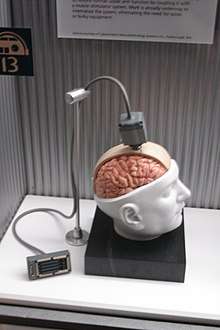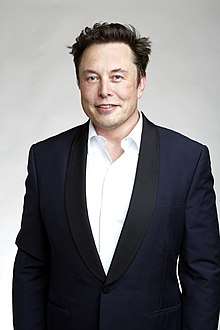Neuralink
Neuralink Corporation is an American neurotechnology company founded by Elon Musk and others, developing implantable brain–machine interfaces (BMIs). The company's headquarters are in San Francisco;[7] it was started in 2016 and was first publicly reported in March 2017.[1][2]
 | |
| Private | |
| Industry | Brain-computer interface Neuroprosthetics |
| Founded | July 2016[1] |
| Founder | Elon Musk[2][3] |
| Headquarters | Pioneer Building, San Francisco, California, U.S. (as of 2020)[4] |
Key people |
|
| Owner | Elon Musk |
Number of employees | 90[6] (2019) |
| Website | neuralink |
According to Bloomberg, since its founding, the company has hired several high-profile neuroscientists from various universities.[8] By July 2019, it had received $158 million in funding (of which $100 million was from Musk) and was employing a staff of 90 employees.[6] At that time, Neuralink announced that it was working on a "sewing machine-like" device capable of implanting very thin (4 to 6 μm in width[9]) threads into the brain, demonstrated a system that read information from a lab rat via 1,500 electrodes and anticipated to start experiments with humans in 2020.[6]
Company overview
_-1.jpg)
Neuralink was founded in 2016 by Elon Musk, Ben Rapoport, Dongjin Seo, Max Hodak, Paul Merolla, Philip Sabes, Tim Gardner, Tim Hanson, and Vanessa Tolosa.[7]
In April 2017, the blog Wait But Why reported that the company aims to make devices to treat serious brain diseases in the short-term, with the eventual goal of human enhancement, sometimes called transhumanism.[10][7][11] Musk said he got partly interested in the idea from a science fiction concept called "neural lace" that is part of the fictional universe in The Culture, a series of 10 novels by Iain M. Banks.[11][12]
Musk defined the neural lace as a "digital layer above the cortex" that would not necessarily imply extensive surgical insertion but ideally an implant through a vein or artery.[13] Musk explained that the long-term goal is to achieve "symbiosis with artificial intelligence",[14] which Musk perceives as an existential threat to humanity if it goes unchecked.[14][15] At the present time, some neuroprosthetics can interpret brain signals and allow disabled people to control their prosthetic arms and legs. Musk aims to link that technology with implants that, instead of actuating movement, can interface at broadband speed with other types of external software and gadgets.[15]
As of 2020, Neuralink is headquartered in San Francisco's Mission District, sharing the former Pioneer Trunk Factory building wih OpenAI, another company co-founded by Musk.[16][4] Musk was the majority owner of Neuralink as of September 2018, but did not hold an executive position.[17] The role of CEO Jared Birchall, who has also been listed as CFO and president of Neuralink, and as executive of various other companies Musk founded or co-founded, has been described as formal.[18][16] The trademark "Neuralink" was purchased from its previous owners in January 2017.[19]
Electrodes
By 2018, the company had "remained highly secretive about its work since its launch", although public records showed that it had sought to open an animal testing facility in San Francisco; it subsequently started to carry out research at the University of California, Davis.[16]
In July 2019, Neuralink held a live-streamed presentation at the California Academy of Sciences. The proposed future technology involves a module placed outside the head that wirelessly receives information from thin flexible electrode threads embedded in the brain.[9] The system could include "as many as 3,072 electrodes per array distributed across 96 threads" each 4 to 6 μm in width.[9][20] The threads would be embedded by a robotic apparatus, with the intention to avoid damaging blood vessels.[9][21] Currently, electrodes are still too big to record the firing of individual neurons, so they can record only the firing of a group of neurons; Neuralink representatives believe this issue might get mitigated algorithmically, but it's computationally expensive and does not produce exact results.[22]
See also
- Brain-computer interface
- Cortical implant
- Kernel
- Neurorobotics
- Surface chemistry of neural implants
- Stentrode
References
- Winkler, Rolfe (March 27, 2017). "Elon Musk Launches Neuralink to Connect Brains With Computers". Wall Street Journal. Archived from the original on May 5, 2017. Retrieved May 4, 2017.
- Statt, Nick (March 27, 2017). "Elon Musk launches Neuralink, a venture to merge the human brain with AI". The Verge. Archived from the original on February 6, 2018. Retrieved September 6, 2017.
- 5 Neuroscience Experts Weigh in on Elon Musk's Mysterious "Neural Lace" Company Archived December 31, 2018, at the Wayback Machine. (PDF) Eliza Strickland. Harvard University. 12 April 2017.
- Hao, Karen (February 17, 2020). "The messy, secretive reality behind OpenAI's bid to save the world". MIT Technology Review. Retrieved March 9, 2020.
- Elon Musk Breaks Twitter Silence on Secretive A.I.-Brain Firm Neuralink Archived December 6, 2018, at the Wayback Machine. Mike Brown, Inverse. 27 November 2018.
- Markoff, John (July 16, 2019). "Elon Musk's Company Takes Baby Steps to Wiring Brains to the Internet". The New York Times. ISSN 0362-4331. Archived from the original on July 17, 2019. Retrieved July 17, 2019.
- Masunaga, Samantha (April 21, 2017). "A quick guide to Elon Musk's new brain-implant company, Neuralink". Los Angeles Times. Archived from the original on May 5, 2017. Retrieved May 4, 2017.
- "Elon Musk's Brain Tech Startup Is Raising More Cash". May 11, 2019. Archived from the original on May 11, 2019. Retrieved May 12, 2019.
The company has hired away several high-profile neuroscientists
- Elon Musk unveils Neuralink’s plans for brain-reading ‘threads’ and a robot to insert them. Archived July 17, 2019, at the Wayback Machine Elizabeth Lopatto, The Verge. 16 July 2019.
- Urban, Tim (April 20, 2017). "Neuralink and the Brain's Magical Future". Wait But Why. Archived from the original on May 4, 2017. Retrieved May 4, 2017.
- Newitz, Annalee (March 27, 2017). "Elon Musk is setting up a company that will link brains and computers". Ars Technica. Archived from the original on May 19, 2017. Retrieved May 4, 2017.
- Cross, Tim (March 31, 2017). "The novelist who inspired Elon Musk". 1843 Magazine. Archived from the original on May 21, 2017. Retrieved May 4, 2017.
- Elon Musk thinks we will have to use AI this way to avoid a catastrophic future Archived February 13, 2019, at the Wayback Machine. Robert Ferris, CNBC News. 31 January 2017.
- Elon Musk believes AI could turn humans into an endangered species like the mountain gorilla Archived December 4, 2018, at the Wayback Machine. Isobel Asher Hamilton, Business Insider. 26 November 2018.
- Everything you need to know about Neuralink: Elon Musk’s brainy new venture Archived December 6, 2018, at the Wayback Machine. Tyler Lacoma, Digital Trends. 7 November 2017.
- Conger, Kate. "Elon Musk's Neuralink Sought to Open an Animal Testing Facility in San Francisco". Gizmodo. Archived from the original on September 24, 2018. Retrieved October 11, 2018.
- No-Action Letter: Neuralink Corp Archived July 20, 2019, at the Wayback Machine. U.S. Securities and Exchange Commission (SEC), October 16, 2018
- Oremus, April Glaser, Aaron Mak, Will (August 17, 2018). "Why Elon Musk's Companies Aren't Melting Down, Even If He Is". Slate Magazine. Archived from the original on July 20, 2019. Retrieved July 20, 2019.
- Meet the Guys Who Sold "Neuralink" to Elon Musk without Even Realizing It, April 4, 2017, MIT Technology Review
- Elon Musk’s Neuralink Aims to Merge Human Brain With A.I. Archived July 29, 2019, at the Wayback Machine Dinker, TechBrackets. 18 July 2019.
- Elon Musk's Neuralink Says It's Ready for Brain Surgery. Archived July 17, 2019, at the Wayback Machine Ashlee Vance, Bloomberg. 16 July 2019.
- "Neuralink Paper Review - Numenta Research Meeting". Numenta, Inc. Archived from the original on July 24, 2019. Retrieved July 27, 2019 – via YouTube.
Further reading
- Neuralink; Musk, Elon (August 2, 2019). "An integrated brain-machine interface platform with thousands of channels". bioRxiv. doi:10.1101/703801. (whitepaper)

